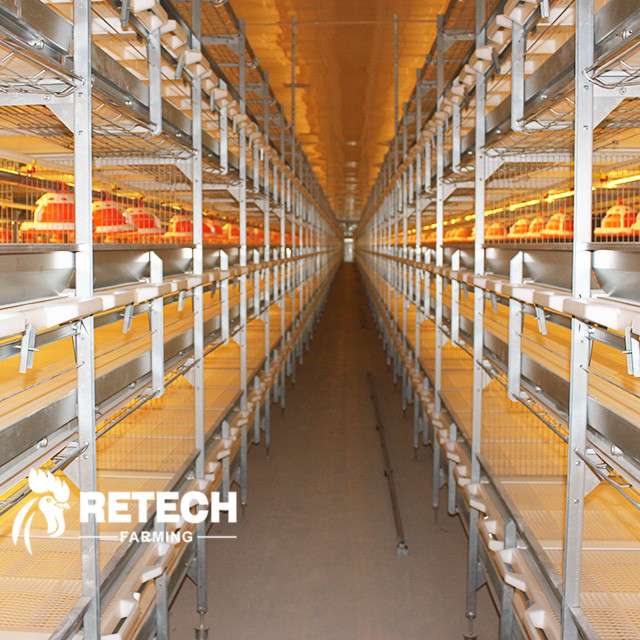การจัดการรายวันของไก่เนื้อการเลี้ยงไก่มี 9 ประเด็น ได้แก่ อุณหภูมิที่ค่อนข้างคงที่ ความชื้นที่เหมาะสม การระบายอากาศ การให้อาหารสม่ำเสมอและปริมาณมาก แสงสว่างที่เหมาะสม น้ำดื่มที่ต่อเนื่อง สุขาภิบาลและการป้องกันโรคระบาดและยา การสังเกตไก่ และบันทึกการให้อาหาร
คุณภาพของรายละเอียดการทำงานเหล่านี้ส่งผลโดยตรงต่อประสิทธิภาพการผสมพันธุ์
1. อุณหภูมิค่อนข้างคงที่
อุณหภูมิหมายถึงระดับความร้อนและความเย็น อุณหภูมิร่างกายของไก่โตเต็มวัยอยู่ที่ประมาณ 41°C และอุณหภูมิร่างกายของลูกไก่แรกเกิดจะต่ำกว่าไก่โตเต็มวัยประมาณ 3°C จนกระทั่งเมื่ออายุได้ 10 วัน อุณหภูมิจะใกล้เคียงกับไก่โตเต็มวัย เมื่อเราพูดว่าอุณหภูมิสูงหรือต่ำ เราหมายถึงอุณหภูมิที่สูงและต่ำสัมพันธ์กัน นั่นคือ อุณหภูมิภายในห้องจะถูกเปรียบเทียบกับอุณหภูมิมาตรฐานของวัน
ผลกระทบของอุณหภูมิต่อไก่เนื้อและแนวทางแก้ไข: สำหรับไก่เนื้อที่โตเร็ว อุณหภูมิสูงหรือต่ำเกินไป หรือการกลายพันธุ์ที่อุณหภูมิจะส่งผลต่ออัตราการเจริญเติบโต โดยเฉพาะอย่างยิ่งเมื่อไก่เนื้อหลังจากเปลี่ยนใหม่มีความอ่อนไหวต่อการกลายพันธุ์ที่อุณหภูมิมากขึ้น ไก่เนื้อจะเจริญเติบโตได้อย่างรวดเร็วและแข็งแรงก็ต่อเมื่อโรงเรือนเลี้ยงไก่เนื้อให้อุณหภูมิที่ค่อนข้างคงที่เพื่อรักษาระดับพลังงานที่จำเป็นของตัวเอง
ในช่วงฟักไข่ อุณหภูมิร่างกายของลูกไก่ต่ำ ทำให้ร่างกายเต็มไปด้วยขนฟู ซึ่งไม่สามารถเก็บความร้อนได้ และปรับตัวเข้ากับอุณหภูมิภายนอกได้ยาก ขนฟูส่งผลโดยตรงต่อการควบคุมอุณหภูมิ การออกกำลังกาย ปริมาณอาหารที่กิน น้ำดื่ม และอัตราการเปลี่ยนอาหารของลูกไก่
ควรรักษาอุณหภูมิให้อยู่ในเกณฑ์มาตรฐานในช่วง 10 วันแรกของการกกไข่ และความแตกต่างของอุณหภูมิระหว่างกลางวันและกลางคืนไม่ควรเกิน ±1 °C หากอุณหภูมิต่ำเกินไป จะทำให้ไข่แดงดูดซึมได้ไม่ดี อาหารไม่ย่อย (ให้อาหารมากเกินไป) ทำให้เกิดโรคทางเดินหายใจ และโรคทรวงอกและขาจะรุนแรงขึ้น หากอุณหภูมิสูงเกินไปและความชื้นต่ำ ไก่จะดื่มน้ำมากเกินไป ทำให้เกิดอาการท้องเสีย กินอาหารน้อยลง และการเจริญเติบโตช้าลง
ระบายอากาศในกรณีที่มีการทำความร้อน ให้ความสำคัญกับการรักษาความร้อนขณะระบายอากาศ และควบคุมความแตกต่างของอุณหภูมิไม่ให้เกิน 3 องศาเซลเซียส ในระยะหลังของการเลี้ยง โดยเฉพาะในช่วงสองวันก่อนออกจากระบบ จำเป็นต้องรักษาอุณหภูมิภายในและภายนอกให้คงที่ตามฤดูกาล กล่าวคือ อุณหภูมิภายนอกสูง อุณหภูมิภายในสูงขึ้นเล็กน้อย อุณหภูมิภายนอกต่ำ และอุณหภูมิภายในสูงขึ้นเล็กน้อย ต่ำ
สามารถลดการสูญเสียชีวิตที่เกิดจากความเครียดระหว่างทางได้ไก่เนื้อกล่าวโดยสรุป อุณหภูมิโดยรอบ การระบายอากาศ และความชื้นเป็นตัวควบคุมอุณหภูมิภายในอาคาร และอุณหภูมิมีบทบาทสำคัญต่อการเจริญเติบโตอย่างรวดเร็วและมีสุขภาพดีของไก่
การเปลี่ยนแปลงของอุณหภูมิอาจทำให้เกิดความเครียดและก่อให้เกิดโรคได้หลากหลาย อุณหภูมิเป็นตัวกำหนดอัตราการเปลี่ยนอาหารเป็นพลังงานและความต้านทานโรค ได้แก่ อุณหภูมิสูง อัตราการเปลี่ยนอาหารเป็นพลังงานสูงแต่ความต้านทานโรคต่ำ อุณหภูมิต่ำ อัตราการเปลี่ยนอาหารเป็นพลังงานต่ำแต่ความต้านทานโรคสูง
คือการเข้าใจ “องศา” ตามสถานการณ์จริง เลือกอุณหภูมิที่เหมาะสมที่สุดในแต่ละฤดูกาลและช่วงเวลา และจัดการกับความขัดแย้งระหว่างอุณหภูมิกับอัตราส่วนของอาหารต่อเนื้อสัตว์ไก่เนื้อไก่สามารถเจริญเติบโตได้เร็วและมีสุขภาพดี
ปัจจัยที่สำคัญที่สุดที่มีผลต่ออุณหภูมิคือการเปลี่ยนแปลงของสภาพอากาศ ดังนั้นเราต้องคอยติดตามการเปลี่ยนแปลงของสภาพอากาศอยู่เสมอ และคำนึงถึงสภาพอากาศในแต่ละสัปดาห์ผ่านการพยากรณ์อากาศ
เวลาโพสต์: 13 มิ.ย. 2565








